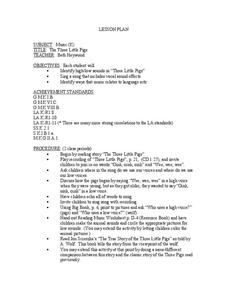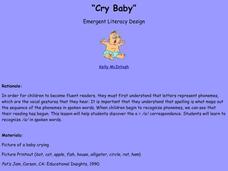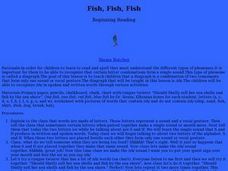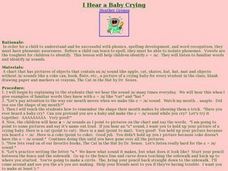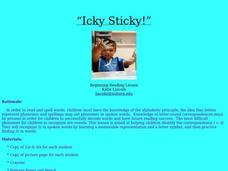Curated OER
I'm Feeling Hot, Hot, Hot
Students recognize the phoneme /h/. Through listening and matching activities, students discriminate the phoneme /h/ from similar looking letters and phonemes. They associate the phoneme /h/ with its letter representation and identify...
Curated OER
Fun with Fish!
Students observe the phoneme and digraph /sh/ in spoken words. They discover a meaningful representation and practicie finding /sh/ in words. They read and spell words (using a letterbox lesson) that contain the phoneme /sh/.
Curated OER
Open Your Mouth and Say Ahh!
Pupils identify and hear distinct sounds in spoken and written language. Then they develop a connection between phonemes and their letter symbols which is a key factor in the success of learning how to read and write. Students also...
Curated OER
Quiet Please
First graders identify the digraph /sh/ in written and spoken language. After a brief discussion of the independent and combined sounds of the phonemes /s/ and /h/ students practice identifying and spelling initial and final placement of...
Curated OER
The Three Little Pigs
Students identify high and low sounds in the "Three Little Pigs" song, sing a song that includes vocal sound effects and identify ways that music relates to language arts. Before singing the song, they have listened to the teacher read...
Curated OER
Bum, Bum, Beat the Drum
Students experience practicing sorting words and pictures to build letter and sound recognition. They identify /b/ in spoken words and learn how to write the graphemic representation of /b/. Each student also practices with the tongue...
Curated OER
Say Aaaaa for Apple
Learners say words by blending sounds and phonemes. They decode words in order to read and identify and understand the letter a. This phoneme /a/ is one of the short vowels that are needed to read and write. They will show example of...
Curated OER
Sesame Street Letter Recognition
Students study the letters of the alphabet, explore different shapes, rhyme, and listen to the different sounds of the alphabet to help them sound out words and begin elementary level reading.
Curated OER
Pop Your P's
Young scholars identify the letter and phoneme /p/ in written and spoken language. Students practice the production of the /p/ sound through songs and tongue twisters. They identify the initial placement of the letter and sound using a...
Curated OER
I Think I Can
Students identify the digraph /ch/ in written and spoken language. Students practice the production of the /ch/ sound through tongue twister. They identify the initial and final placement of the digraph /ch/ by reading a story to a partner.
Curated OER
Cry Baby
Students recognize the short vowel a in written and spoken language. Through matching and listening activities, they discriminate the vowel sound /a/ from other phonemes. Students associate the phoneme with its letter representation...
Curated OER
Fish, Fish, Fish
Students identify the digraph /sh/ in written and spoken language. After a brief discussion the independent and combined sounds of the phonemes /s/ and /h/ students practice identifying initial and final placement of the new digraph /sh/...
Curated OER
Cracking Sticks
Students explore the letter /k/ in this lesson, and identify the /k/ sound in words. They read a tongue twister emphasizing the /k/ sound, and discuss that two letters make the /k/ sound - c and k. They then practice writing k's and...
Curated OER
Chug-a-Chug-a Choo Choo
First graders identify the digraphs in written and spoken language. After a brief discussion on the combinations of letters that comprise digraphs, 1st graders practice identifying initial and final placement of the digraph /ch/ in words...
Curated OER
I Hear a Baby Crying
Students recognize the short vowel a in written and spoken language. Through matching activities, they discriminate the short vowel /a/ from other phonemes. Students associate the phoneme with its letter representation and identify the...
Curated OER
Elephants Enjoy Eating Eggs
Pupils recognize the short vowel e in written and spoken language. Through listening and matching activities, they discriminate the vowel sound /e/ from other phonemes. Students practice using the phoneme and letter in words by writing...
Curated OER
Fishy Fun
Students review the correspondent /ai/ = long a and break into groups of five. They use a fishing pole with a magnet attached to "fish" for words that contain the /ai/ sound in it. If they catch a word that does not contain the /ai/...
Curated OER
Which Letter Comes First?
In this literacy worksheet, students find the pictures that correlate to the words and they also decide which letter to begin the spelling of each word.
Curated OER
Max's Magic Magnets
Pupils identify the letter and phoneme /m/ in written and spoken language. Students practice the production of the /m/ sound through tongue twisters and stories. They identify the initial placement of the letter and sound using a picture...
Curated OER
Icky Sticky
Students recognize the short vowel i in written and spoken language. Through matching and listening activities, they discriminate the vowel sound /i/ from other phonemes. Students identify the phoneme and letter in words and pictures.
Curated OER
Sneaky Snake
Students examine the letter 's'. Through instruction and modeling they explore the sound the letter makes, how the letter is written, words that contain the letter, etc. They listen to a story and identify words with the /s/ sound by...
Curated OER
Chocolate Chicken
Students identify digraphs in written and spoken language. After a brief discussion on the combinations of letters that comprise digraphs, students practice identifying initial and final placement of the digraph /ch/ in words and tongue...
Curated OER
Say Ahh!!
Students identify the short /o/ sound in spoken words, and recognize the letter symbol /o/. They say a tongue twister emphasizing words with the short /o/ sound. They then listen to the story "In the Big Top" and identify the words...
Curated OER
Let's Ride The Train
Students explore the digraph /ch/. They read and spell words with /ch/ and practice making the /ch/ sound by saying tongue twisters. They observe the teacher writing a /ch/ word and then write their own ch's. Students hold up a green...




